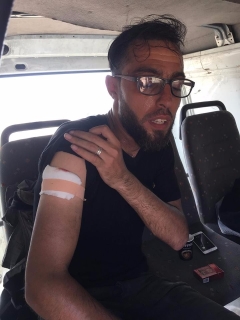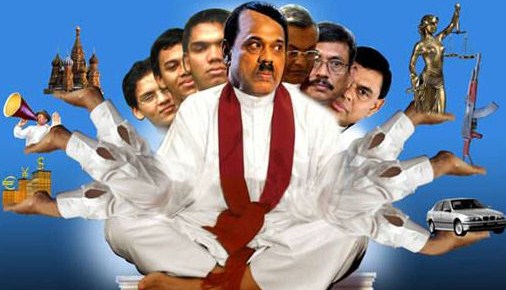A Brief Colonial History Of Ceylon(SriLanka)
Sri Lanka: One Island Two Nations
A Brief Colonial History Of Ceylon(SriLanka)
Sri Lanka: One Island Two Nations
(Full Story)
Search This Blog
Back to 500BC.
==========================
Thiranjala Weerasinghe sj.- One Island Two Nations
?????????????????????????????????????????????????Saturday, April 14, 2018
One Palestinian killed, 700 injured in Gaza on third Friday of protests
Thousands of Gazans demonstrate on third Friday of the Great March of Return, with 33 killed since 30 March

Palestinians take cover from tear gas smoke fired by Israeli forces east
of Gaza City in the central Gaza Strip on 13 April (AFP)

Friday 13 April 2018
One Palestinian was killed, and more than 700 were injured on the third
Friday of large-scale demonstrations in the Gaza Strip, as they came
under fire from Israeli forces at the border.
Thousands of Gazans are taking part in protests in the besieged enclave,
where almost 1.3 million of the small territory’s two million
inhabitants are refugees, to demand the right to return to their
pre-1948 homes.
The Ministry of Health reported than 701 Palestinians were wounded as of
6pm, mainly by tear gas and live bullets. An MEE correspondent on the
ground said at least one demonstrator was in critical condition after
being shot in the head east of Gaza City.
The planned six-week protest, which began on 30 March on Palestinian
Land Day, is set to end on 15 May - the 70th anniversary of the
Palestinian Nakba (Catastrophe), in which more than 700,000 Palestinians
were forcibly displaced by Israeli forces in 1948 Arab-Israeli war.
In total, 33 Palestinians have been killed and thousands wounded by
Israeli forces since the "Great March of Return" began on 30 March.
While demonstrators have gathered at tent encampments along the border
every day since the protests began, higher numbers have protested on
Fridays.
Journalists, medics in the line of fire as scores injured
The Gaza Ministry of Health reported around 2:30pm on Friday that a
Palestinian was killed by Israeli forces in the area of Khuzaa in the
southern Gaza Strip, only to later retract the statement and clarify
that the man was in critical condition after having been shot in the
head.
At least three other Palestinians were reportedly shot in the head and
in critical condition - one east of Gaza City, and two east of Rafah.
Mohammed al-Hajjar, a Palestinian photographer working with Middle East
Eye in Gaza, was lightly injured in the arm after being grazed by a
bullet. Meanwhile, Palestinian media reported that another journalist,
Ahmad Abu Hussein, was shot in the abdomen east of the town of Jabaliya
in the northern Gaza Strip and was in critical condition.
An MEE correspondent in the area of Karni east of Gaza said it appeared
Israeli forces were deliberately targeting press and TV vehicles located
700 metres from the Israeli-constructed separation fence, using large
quantities of tear gas, while warning on loudspeakers that anyone
approaching the fence would be shot.
 Palestinian photojournalist Mohammed al-Hajjar
Palestinian photojournalist Mohammed al-Hajjar
In the Khan Younis area, the Ministry of Health said a medical tent had
been targeted by Israeli forces, causing 10 medics to suffer from
excessive tear gas inhalation and "hindering the work of medical staff".
Meanwhile, the Palestinian Red Crescent Society confirmed that Israeli
forces shot one of its medics in the knee near Rafah.
Israel's
army alleged there were attempts to damage and breach the fence
separating Gaza from Israel, while it said firebombs and "an explosive
device" were thrown. Palestinians also sought to pull away barbed
wire set up by Israeli forces to keep them away from the fence, an AFP
journalist said.
The
military said soldiers were responding "with riot dispersal means and
are firing in accordance with the rules of engagement."
Earlier
on Thursday evening, Israeli troops shot and killed a Palestinian man
near the Gaza border, the Gaza Ministry of Health said. The ministry said Abdullah al-Shahari, 28, was shot in the chest east of Khan Younis.
An
Israeli army spokesperson told Middle East Eye on Friday morning that
they would look into whether the army had carried out any operations
near Khan Younis on Thursday evening, and said that the army “cannot
comment on what is happening inside Gaza”.
A Hamas fighter,
identified as Mohammed Hijaila, was killed by an Israeli strike in the
Gaza Strip earlier on Thursday, the health ministry said. Israel said
the air raid was in response to gunfire aimed at an Israeli warplane
carrying out earlier strikes, which in turn followed a bomb blast at
Israel's fence on Wednesday.
Flag burning
In the northern Gaza Strip, Sumaya Abu Awad, 36, attended the protest with her three daughters and son.
"I
am from the village of Hiribya and it is my right to return to it," she
told AFP, referring to a village north of Gaza destroyed in the 1948
war surrounding Israel's creation.
"I am not afraid of death because there is no life in Gaza already."
I am not afraid of death because there is no life in Gaza already- Sumaya Abu Awad, refugee
While last Friday's protest was dubbed "Jum'at al-Kawshook", literally
meaning "Tyres Friday", as demonstrators burned tyres to obscure the
view of Israeli troops targeting the crowds with live ammunition, this
week demonstrators were encouraged to burn Israeli flags and raise
Palestinian ones.
In northern Gaza, a large Israeli flag was burned that had earlier been set on the ground for protesters to walk over, while dozens of Israeli flags were being burned in Jabalia in northern Gaza and hundreds of Palestinian ones were held aloft.
Near
Khan Younis in the south, protesters burned pictures of Israeli Prime
Minister Benjamin Netanyahu, US President Donald Trump and Saudi Crown
Prince Mohammed bin Salman, whom they view as cooperating with Israel.
Hamas spokesman Fawzi Barhum expressed his support of setting Israeli flags aflame.
حرق الجماهير للعلم الإسرائيلي رسالة لكل المطبعين وللعالم أجمع أنه لن يستطيع كائنا من كان منح شرعية للإحتلال على أرض فلسطين و أن الشعب الفلسطيني هو صاحب الأرض والقرار.
Translation: The crowd’s burning of
the Israeli flag is a message to all media and to the whole world that
no one can grant legitimacy to the occupation of the land of Palestine.
The Palestinian people are the owners of the land and its decision
makers.
“I
am here today to raise high the Palestinian flag, and burn the Israeli
flag. I refuse to make peace with the Israelis who kill us and besiege
us, and the whole world should know this,” Ahmed Abu Batnein told MEE.
The 25-year-old demonstrator said that while he had come to protest with
his whole family, he had ordered that his 14-year-old brother Mustafa
stay far back at the tent encampments.
“I want to keep my brother away from the border after seeing how children are being killed, like last Friday with child martyr Hassan Madi, who was only 15 years old,” he said.
Reports emerged on Israeli media that protesters were calling Friday
"Molotov Day" and planning on throwing improvised incendiary devices in
the direction of Israeli forces.
However, one of the March of Return's organisers told Israeli newspaper Haaretz that
"Israel is trying in every way to pin the marches on Hamas and it's
very convenient for them if this action becomes violent on the
Palestinian side, and that's why we won't allow it."
Inside Israel, in the city of Sderot only a few kilometres from Gaza, a
handful of Israelis demonstrated to denounce the military's actions in
Gaza, receiving invectives from passerbys.
הסכסוך הישראלי : צומת יד מרדכי, צעירים משדרות מתעמתים עם מפגיני שמאל על רקע ארועי הגדר. pic.twitter.com/saxHbZwK6Z— יוסי יהושוע (@YehoshuaYosi) 13 April 2018
הסכסוך הישראלי : צומת יד מרדכי, צעירים משדרות מתעמתים עם מפגיני שמאל על רקע ארועי הגדר.
Translation: At Yad Mordechai
Junction, young people from Sderot confront left-wing demonstrators
against the backdrop of the fence.
Nomika Zion, one of the members of Other Voice, a Sderot-based group
calling for an end to the Israeli military blockade of Gaza, told MEE
that its demonstrators have been on the receiving end of violent
reactions from fellow Israelis in the past few weeks, including thrown
objects and an attempt to run them over.
"We come from Sderot, and we see first hand the vicious cycle of
violence," she said. "We have a responsibility towards the people of
Gaza. It is my moral obligation to raise my voice even though it's
unpopular."
Gaza medical services strained
The Gaza Ministry of Health announced that hospitals and medical
personnel were on high alert as of Friday morning to deal with the
anticipated influx of casualties.
The
UN Office for the Coordination of Humanitarian Affairs (OCHA) has
raised concerns about Gaza’s capacity to handle thousands of wounded in
the past several weeks, highlighting the besieged enclave’s already
strained resources.
“Gaza’s
health sector has struggled to cope with the mass influx of casualties,
due to years of blockade, internal divide and a chronic energy crisis,
which have left essential services in Gaza barely able to function,” the
UN agency said in a statement on Friday.
OCHA reported 2,870 Palestinians wounded between 30 March and 11 April.
“The
large number of casualties among unarmed demonstrators, including a
high percentage of demonstrators hit by live ammunition, has raised
concerns about excessive use of force,” it stated.
Israeli
army forces have been stationed along the fence separatingt Gaza from
Israel for the past two weeks, using tear gas, snipers firing live
ammunition, tank shelling, and air strikes.
Palestinian
demonstrators have burned tyres and thrown stones in the direction of
Israeli troops. No Israeli casualties have been reported.
Organisers
of the protests have maintained that the demonstration is largely
peaceful, and rejected Israeli accusations that Hamas is behind it,
saying the rallies are independent and the Islamist movement is one of
many groups involved.
UN
Secretary General Antonio Guterres, the European Union and others have
called for an independent investigation into the killings, including
that of Palestinian journalist Yasser Murtaja, who was shot while wearing a vest clearly marked “Press”.
Israel has rejected calls for a probe and insists its open-fire rules for Gaza will not change.
Amnesty
International called on Israel to “urgently reverse their policies and
abide by their international legal obligations” on Friday.
“For
the past two weeks, the world has watched in horror as Israeli forces
unleashed excessive, deadly force against protesters, including
children, who merely demand an end to Israel’s brutal policies towards
Gaza and a life of dignity,” said Magdalena Mughrabi, Amnesty
International’s deputy director for the Middle East and North Africa.
“Israeli
authorities must respect the Palestinians’ right to peaceful protest
and, in the event that there is violence, use only the force necessary
to address it. Under international law, lethal force can only be used
when unavoidable to protect against imminent threats to life.”

